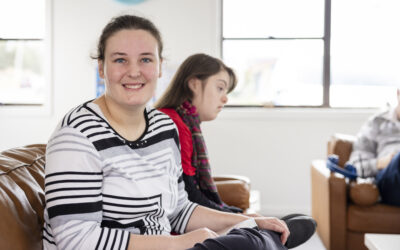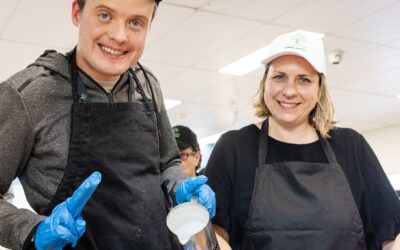Every individual with a disability has distinct goals, preferences and circumstances. There is no one size fits all approach for everyone. Getting the right support begins by understanding those differences and planning around them.
This approach is called person-led planning, a key principle in modern disability support. It helps people move away from set programs. They choose their own goals and then take steps to building a life that’s right for them.
What is person-led planning?
Person-led planning means placing the individual at the centre of every decision about their care and services. It asks practical questions such as:
- What do you want your life to look like?
- What skills or experiences matter most to you?
- Who or what brings you the most joy each day?
From there, the person works alongside family, friends, support staff and other professionals to build a plan that reflects their preferences and long-term aspirations.
This method allows for flexibility and personal choice. It aligns closely with the principles of the National Disability Insurance Scheme (NDIS), which promotes control and independence for people with disability.
Why person-led planning matters in disability support
Placing the person first has profound effects on their quality of life. Some of the most critical outcomes include:
- Building self-determination by encouraging people to make their own decisions about where they live, who they spend time with and what they’re working towards.
- Improving wellbeing by linking daily support to personal goals such as study, work, social participation or life skills development.
- Strengthening confidence and resilience by making sure the person’s voice drives every stage of the planning process.
These changes may seem simple, but over time they allow people to grow, explore and create lives that feel truly their own.
Service-centred vs person-centred planning
Side-by-side breakdown
| Person-centred planning | Service-centred planning | |
| Focus | Individual goals, strengths and preferences | Predefined programs and provider priorities |
| Decision-making | Driven by the person and their network | Driven by the service or system |
| Flexibility | Adapts as life circumstances change | Limited, often fixed once services are assigned |
| Collaboration | Inclusive of family, friends, professionals | Minimal outside input beyond the provider |
| Outcomes | Personal growth, independence and community connection | Basic needs met but limited opportunity for self-direction |
Traditional disability support was often service-centred. Services were designed first, and people were expected to fit within existing programs or rules. This person-centred approach can be efficient for providers, but frequently leaves individuals with little say in their own lives.
Person-led planning flips that structure. Instead of asking “Which program can we place this person into?”, it starts with “What does this person want and need?” The plan then draws from available services to build a life around those priorities.
In decades of working alongside people with disabilities, we’ve seen how service-centred planning can stall growth. It may keep someone safe and comfortable, but it rarely builds the skills, confidence or independence needed to thrive beyond routine care.
Person-centred approach is collaborative and flexible. It respects lived experience, adapts as life changes and actively involves family and community networks. The shift empowers people to lead their own journey rather than simply receive care.
Daniel’s Story: Building the life he wants with person-led planning
When Daniel began planning his future, he wanted a plan that reflected his goals, his choices, and his dreams.
Daniel is 27 and lives in a Sunnyfield Supported Independent Living (SIL) home with two housemates. He loves cooking, and has always dreamed of working in a café. Daniel created a person-led plan, with support from his Sunnyfield team, that focused on what really matters to him: becoming more independent, finding meaningful work, and being part of his local community.
Daniel identified clear goals for the year ahead, and with support from his team the steps needed to get there:
- At home: Daniel started cooking more of his own meals. With support from his favourite Sunnyfield workers, he now plans the weekly menu, shops for groceries, and cooks dinner for his housemates twice a week.
- At work: Through a Sunnyfield supported employment program, Daniel found a role at a local café. He’s learning to make sandwiches, serve customers, and even brew coffee on the espresso machine — something he’s really proud of.
- In the community: Daniel takes part in a weekly local cooking class and volunteers at a community garden, where he’s made new friends and discovered a love of growing herbs and vegetables.
Today, Daniel reports that his life feels more his own. Each step of his plan helps him build the confidence and skills to live the way he wants.
That’s the power of a person-led approach — it starts with placing each person in the driving seat, listening to what matters most to them, and then walking alongside them as they make it happen.
Key benefits of person-led planning
When planning is genuinely person-led, the impact reaches far beyond a support plan on paper. Here are the benefits we see most often; benefits which can also be seen in the case study provided above:
Choice and control over life decisions
A well-designed plan starts with asking what the person actually wants, not what a service happens to offer. This can mean deciding where to live, choosing social or recreational activities or shaping a weekday routine around personal interests. Having this level of control does more than improve daily satisfaction; it builds self-confidence and helps people see themselves as the driver of their own future.
Better long-term outcomes
When someone sets goals that feel important and relevant to them, motivation grows naturally. Over time, we have seen people gain new life skills, hold down supported employment roles, take on volunteering or study and transition to more independent living. These milestones often last because they’re built around genuine personal ambition rather than generic program milestones.
Stronger relationships and support networks
Planning in this way encourages the active involvement of family, friends and trusted professionals from the start. This creates a clear, shared vision and a stronger circle of support. In our work, this approach often leads to better continuity of care: Families feel heard, professionals stay connected to the same goals and the support journey feels less fragmented.
Flexibility as life changes
A person’s needs and priorities evolve over time. A strong person-centred plan is treated as a living document that can adapt to significant life events such as finishing school, entering the workforce, moving to a new home or recovering from health changes. Such adaptability keeps the plan useful rather than letting it become outdated or restrictive.
Improved collaboration across services
Many people with disability interact with several professionals like therapists, doctors, educators and support workers. Person-led planning creates a clear shared roadmap, reducing overlap, gaps and confusion. We often see smoother communication and faster problem-solving when everyone works to the same individualised plan.
A stronger sense of belonging
Personalised planning helps people feel seen and valued in their communities. When supports reflect someone’s personality and interests, they are more likely to connect with others, join groups and feel included. Over decades, we have witnessed how this sense of belonging can transform confidence and overall wellbeing.
How Sunnyfield applies person-centred approach in real life
In our over 70 years of supporting people with intellectual disability, we have learned that a good plan is built through conversation, trust and action. Our approach begins by sitting down with the person, their family and anyone else they wish to involve. Together, we discuss everyday life: what’s working well, what needs to change and what goals feel exciting or important.
From there, a plan might cover:
- Individual goal setting, such as learning to cook, travelling independently or exploring new hobbies.
- Accommodation planning that matches lifestyle preferences and levels of independence.
- Community participation, such as sports, creative programs or volunteering, that spark confidence and connection.
- Employment and training pathways that develop real-world skills and lead to increased income.
Because every plan is unique, our support workers, coordinators and allied professionals stay closely involved. They help put the plan into action and adapt as life changes.
This hands-on approach reflects our long history: from the first Sunnyfield home created by families in 1952 to the almost 2,000 services we now deliver across New South Wales.
Build a life that feels truly yours with Sunnyfield
Person-led planning means more than a paperwork exercise. It’s about creating a life that reflects who someone is and what they want for the future. If you’re exploring disability support and want a plan shaped around real goals and personal choice, reach out to us. We can discuss how person-led planning can benefit you or someone you care about.




